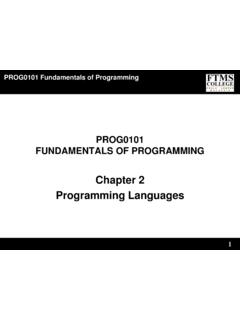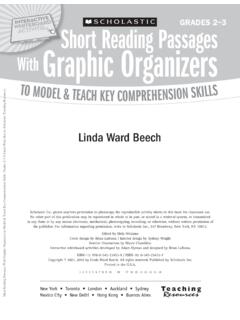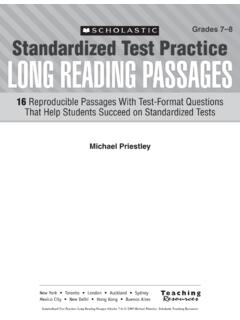Transcription of Stepwise versus Hierarchical Regression: Pros and Cons ...
1 Running head: Stepwise versus Hierarchal Regression Stepwise versus Hierarchical Regression: Pros and Cons Mitzi Lewis University of North Texas Paper presented at the annual meeting of the Southwest Educational Research Association, February 7, 2007, San Antonio. Stepwise versus Hierarchical Regression, 2 Introduction Multiple regression is commonly used in social and behavioral data analysis (Fox, 1991; Huberty, 1989). In multiple regression contexts, researchers are very often interested in determining the best predictors in the analysis.
2 This focus may stem from a need to identify those predictors that are supportive of theory. Alternatively, the researcher may simply be interested in explaining the most variability in the dependent variable with the fewest possible predictors, perhaps as part of a cost analysis. Two approaches to determining the quality of predictors are (1) Stepwise regression and (2) Hierarchical regression. This paper will explore the advantages and disadvantages of these methods and use a small SPSS dataset for illustration purposes. Stepwise Regression Stepwise methods are sometimes used in educational and psychological research to evaluate the order of importance of variables and to select useful subsets of variables (Huberty, 1989; Thompson, 1995).
3 Stepwise regression involves developing a sequence of linear models that, according to Snyder (1991), can be viewed as a variation of the forward selection method since predictor variables are entered one at a Stepwise versus Hierarchical Regression, 3 time, but true Stepwise entry differs from forward entry in that at each step of a Stepwise analysis the removal of each entered predictor is also considered; entered predictors are deleted in subsequent steps if they no longer contribute appreciable unique predictive power to the regression when considered in combination with newly entered predictors (Thompson, 1989).
4 (p. 99) Although this approach may sound appealing, it contains inherent problems. These problems include (a) use of degrees of freedom, (b) identification of best predictor set of a prespecified size, and (c) replicability (Thompson, 1995). Degrees of Freedom Using incorrect degrees of freedom results in inflated statistical significance levels when compared to tabled values, a phenomenon that was found to be substantial in a survey of published psychological research (Wilkinson, 1979). The most widely used statistical software packages do not correctly calculate the correct degrees of freedom in Stepwise analysis, and they do not print any warning that this is the case (Thompson, 1995; Wilkinson, 1979).
5 This point is emphasized by Cliff (1987) in his statement that most computer programs for multiple regression are Stepwise versus Hierarchical Regression, 4 positively satanic in their temptation toward Type I errors in this context (p. 185). How are these degrees of freedom incorrectly calculated by software packages during Stepwise regression? Essentially, Stepwise regression applies an F test to the sum of squares at each stage of the procedure. Performing multiple statistical significance tests on the same data set as if no previous tests had been carried out can have severe consequences on the correctness of the resulting inferences.
6 An appropriate analogy is given by Selvin and Stuart (1966): the fish which don t fall through the net are bound to be bigger than those which do, and it is quite fruitless to test whether they are of average size. Not only will this alter the performance of all subsequent tests on the retained explanatory model it may destroy unbiasedness and alter mean-square-error in estimation. (p. 21) However, as noted by Thompson (1995), all applications of Stepwise regression are not equally evil regarding the inflation of Type I error (p. 527).
7 Examples include situations with (a) near zero sum of squares explained across steps, (b) small number of predictor variables, and/or (c) large sample size. Stepwise versus Hierarchical Regression, 5 Best Predictor Set of a Prespecified Size The novice researcher may believe that the best predictor set of a specific size s will be selected by performing the same s number of steps of a Stepwise regression analysis. However, Stepwise analysis results are is dependent on the sampling error present in any given sample and can lead to erroneous results (Huberty, 1989; Licht, 1995; Thompson, 1995).
8 Stepwise regression will typically not result in the best set of s predictors and could even result in selecting none of the best s predictors. Other subsets could result in a larger effect size and still other subsets of size s could yield nearly the same effect size. Why is this so? The predictor selected at each step of the analysis is conditioned on the previously included predictors and thus yields a situation-specific conditional answer in the context (a) only of the specific variables already entered and (b) only those variables used in the particular study but not yet entered (Thompson, 1995, p.)
9 528). The order of variable entry can be important. If any of the predictors are correlated with each other, the relative amount of variance in the criterion variable explained by each of the predictors can change drastically when the order of entry is changed (Kerlinger, 1986, p. 543). A predictor with a Stepwise versus Hierarchical Regression, 6 statistically nonsignificant b could actually have a statistically significant b if another predictor(s) is deleted from the model (Pedhazur, 1997). Also, Stepwise regression would not select a suppressor predictor for inclusion in the model when in actuality that predictor could increase the R2.
10 The explained variance would be increased when a suppressor predictor is included because part of the irrelevant variance of the predictor on the criterion would be partialled out (suppressed), and the remaining predictor variance would be more strongly linked to the criterion. Thompson (1995) shared a literal analogy to this situation from one of his students of picking a five-player basketball team. Stepwise selection of a team first picks the best potential player, then in the context of the characteristics of this player picks the second best potential player, and then proceeds to pick the rest of the five players in this manner.


















